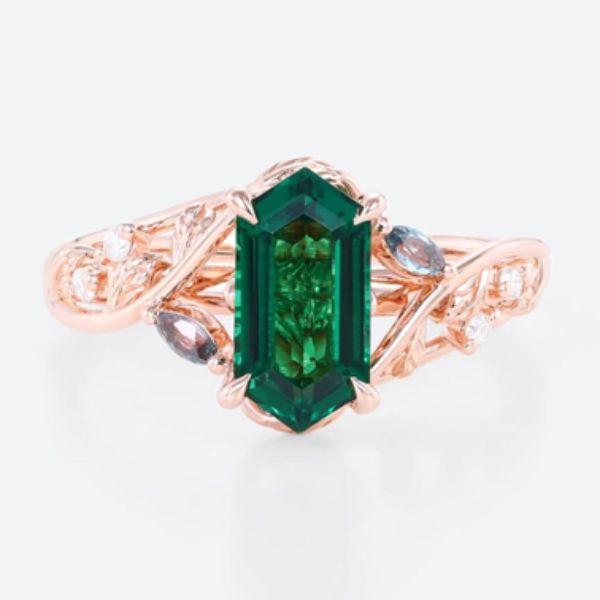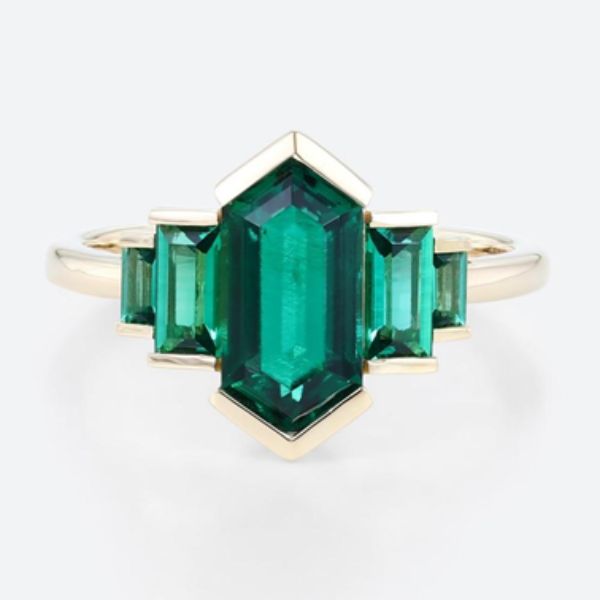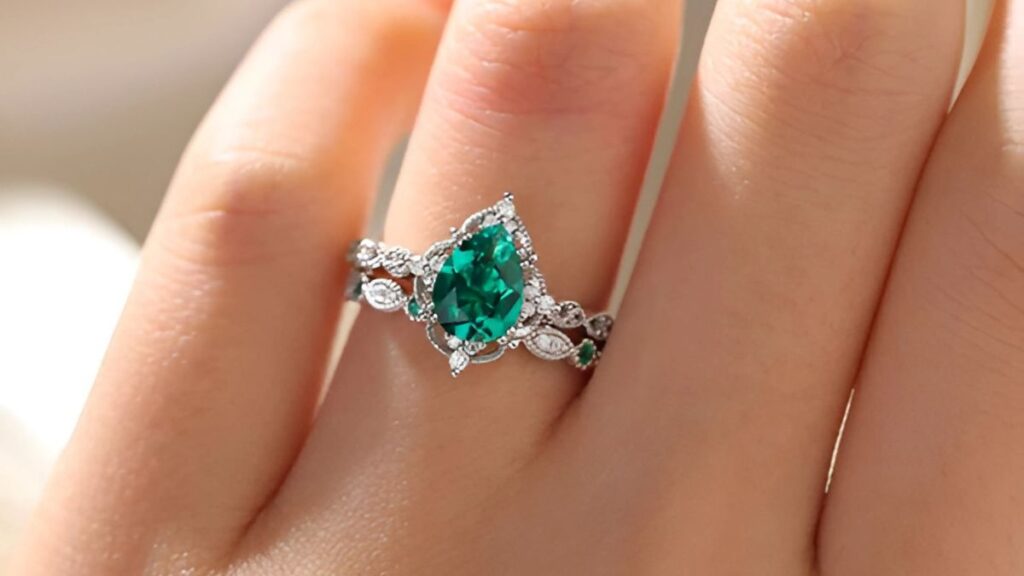Emeralds have fascinated humanity for centuries, cherished by royalty, adorned by celebrities, and sought after by collectors worldwide. With their mesmerizing green hues and rich historical significance, these gemstones symbolize renewal, wisdom, and prosperity. Yet, not all emeralds come from deep within the Earth—some are born in laboratories, crafted through advanced scientific techniques.
But how do lab-created emeralds compare to their natural counterparts? Are they truly the same in beauty, durability, and value? Understanding the differences between these two types of emeralds can help you make an informed decision when purchasing fine jewelry.
LisaJewelryUS is known for offering exquisite jewelry while also helping customers explore the fascinating world of gemstones. In this article, the brand takes a closer look at the characteristics of both natural and lab-created emeralds, outlining their similarities, differences, and what makes each one uniquely special.
I. The Basics of Emeralds
1. The History and Cultural Significance of Emeralds
Emeralds have been cherished for thousands of years, dating back to ancient civilizations. The first recorded emerald mines were in Egypt, where Cleopatra famously adored these verdant gems, considering them symbols of eternal youth and power. The Incas and Aztecs in South America also prized emeralds, believing they had divine properties.
Throughout history, emeralds have been associated with rebirth, love, and wisdom. Many cultures believe they bring good fortune and emotional balance to those who wear them. Today, emeralds remain one of the most coveted gemstones, often featured in engagement rings, heirloom jewelry, and high-fashion accessories.
Emeralds also hold religious and spiritual significance. In some traditions, they are believed to enhance intuition and provide protection against negative energy. Many famous historical figures, from Indian Maharajas to European monarchs, have treasured emeralds for their perceived mystical properties and regal allure.

2. Physical and Chemical Properties of Emeralds
Emeralds belong to the beryl mineral family, sharing their composition with aquamarines and morganites. Their distinctive green color comes from trace amounts of chromium, vanadium, or iron within the crystal structure.

- Hardness: Emeralds have a hardness rating of 7.5 to 8 on the Mohs scale, making them durable but more brittle than diamonds and sapphires due to internal inclusions.
- Color: The most valuable emeralds exhibit a deep, rich green with a hint of blue, often referred to as “emerald green.”
- Inclusions: Almost all natural emeralds contain inclusions, commonly referred to as “jardin” (French for “garden”), giving each stone a unique fingerprint.
- Rarity: High-quality, flawless natural emeralds are exceptionally rare, making them some of the most expensive gemstones on the market.
Understanding these fundamental properties sets the stage for comparing natural and lab-created emeralds. In the next sections, we will explore how these emeralds are formed, their market value, and their impact on sustainable jewelry trends.
II. Natural Emeralds in Detail
1. Formation and Mining Process
Natural emeralds take millions of years to form under specific geological conditions. They originate deep within the Earth’s crust when beryllium-rich fluids interact with chromium and vanadium-bearing rocks under immense heat and pressure. Over time, these elements crystallize, forming the vibrant green gemstone we recognize today.
Due to the intense geological processes involved, natural emeralds often develop inclusions and fractures. These imperfections, known as “jardin,” are not flaws but rather evidence of their natural origin. Because of their rarity, natural emeralds command high prices, especially when they exhibit deep green coloration with minimal inclusions.
Emeralds are mined in several countries, with Colombia being the most famous source of high-quality stones. Colombian emeralds are prized for their pure green color and minimal yellowish or bluish hues. Other major sources include Brazil, Zambia, and Afghanistan, each producing emeralds with distinct characteristics.
Mining emeralds is a delicate and labor-intensive process. Unlike diamonds, which are found in kimberlite pipes, emeralds are typically mined from host rocks using tunnel or open-pit mining. The fragile nature of emeralds requires careful extraction to prevent damage, adding to their high cost.

2. Quality Assessment and Rarity
The quality of a natural emerald is determined by four main factors: color, clarity, cut, and carat weight.
- Color: The most valuable emeralds display a deep, intense green with slight bluish undertones. The presence of chromium and vanadium contributes to this highly sought-after hue.
- Clarity: Unlike diamonds, emeralds are accepted with visible inclusions, as long as they do not overly affect transparency or durability. A nearly flawless emerald is extremely rare and commands a premium price.
- Cut: Emeralds are often cut in a unique “emerald cut” shape, which maximizes the stone’s color and minimizes stress on the gemstone’s delicate structure.
- Carat Weight: Larger emeralds with excellent color and clarity are rarer and exponentially more valuable.
Due to these factors, finding a high-quality, untreated natural emerald is a challenge. Many natural emeralds undergo treatments, such as oiling, to enhance clarity and durability. This is an industry-accepted practice but can affect the stone’s long-term stability.
3. Market Value and Pricing Trends
Natural emeralds are significantly more expensive due to their rarity and mining costs. High-quality, untreated natural emeralds can fetch thousands or even millions of dollars per carat, depending on their origin, color, and clarity.

- Colombian emeralds: Considered the finest in the world, they command the highest prices.
- Zambian emeralds: Known for their slightly bluish-green hues, they are often more affordable than Colombian stones but still highly valuable.
- Brazilian emeralds: Often lighter in tone, these emeralds tend to be less expensive but still beautiful and desirable.
The demand for emeralds in fine jewelry and investment markets continues to drive prices upward. Rare, untreated emeralds are particularly attractive to collectors and investors, making them a lucrative asset in the gemstone industry.
III. Appearance and Quality Comparison
1. Color and Clarity Differences
Emeralds are celebrated for their lush green color, a trait that is highly valued by gem enthusiasts. However, there are notable differences in the color and clarity of natural and lab-created emeralds.
- Natural Emeralds: One of the primary defining features of a natural emerald is its inclusions, which are often referred to as “jardin” (French for “garden”). These inclusions are microscopic minerals or gas bubbles trapped inside the stone during its formation deep within the Earth. These inclusions give each natural emerald its own unique fingerprint and are often seen as a sign of authenticity. While some buyers may find inclusions in emeralds to be a negative trait, they are actually considered desirable by many as they add character and proof of the stone’s natural origin.
The color of natural emeralds is typically a deep, vivid green with hints of blue or yellow, depending on the specific composition of elements like chromium or vanadium. The finest natural emeralds exhibit a clear, intense green, but due to natural variations, achieving the perfect shade can be incredibly rare and expensive.
- Lab-Created Emeralds: Lab-created emeralds are cultivated in controlled environments, where the growth process can be carefully managed. As a result, these emeralds tend to exhibit superior clarity with fewer inclusions. While lab-created emeralds can still feature some inclusions (typically in the form of tiny gas bubbles or microscopic minerals), they are generally far less noticeable than in natural stones. This makes lab-created emeralds especially appealing for those seeking an emerald with high transparency and brilliance.
Color-wise, lab-created emeralds can match the vibrant green hues of their natural counterparts. In fact, because the growth conditions are so meticulously controlled, lab-created emeralds may even have a more consistent color saturation throughout the stone. However, for some connoisseurs, the very uniformity of color in lab-grown emeralds can make them seem less “natural” in appearance.
2. Durability and Hardness
Both natural and lab-created emeralds are made of the same mineral, beryl, which gives them a hardness rating of 7.5 to 8 on the Mohs scale. This means they are durable enough for everyday wear but can be more prone to scratching than diamonds or sapphires, which have higher ratings on the scale.
However, the presence of inclusions in natural emeralds can affect their structural integrity. While inclusions are a natural characteristic of the gemstone, they can also create points of weakness within the stone. This makes some natural emeralds more prone to cracking or chipping under pressure, especially if the emerald has large or visible inclusions.
In contrast, lab-created emeralds tend to have fewer inclusions, which can enhance their resilience. Since the formation process occurs in a controlled environment, these emeralds are less likely to have internal fractures, making them slightly less fragile than their natural counterparts. This makes lab-created emeralds an attractive option for those seeking a stone that is both stunning and more durable for everyday jewelry.

IV. Price Comparison
When it comes to price, natural emeralds and lab-created emeralds differ significantly.
- Natural Emeralds: Natural emeralds are highly valued due to their rarity and the extensive mining process required to extract them from the Earth. The price of natural emeralds is largely determined by the quality of the stone—factors such as color saturation, clarity, size, and the number of inclusions all affect the final price. Top-tier natural emeralds, especially those with minimal inclusions and the coveted “emerald green” color, can be extremely expensive, often commanding prices of several thousand dollars per carat. Emeralds from renowned sources like Colombia, Zambia, and Brazil tend to be the most prized, and those with fewer inclusions are rare and highly sought after.
- Lab-Created Emeralds: Lab-created emeralds, on the other hand, are far more affordable than natural emeralds. While they share the same chemical and physical properties, they are priced significantly lower because they can be produced in a fraction of the time it takes to form a natural emerald. The cost of a lab-created emerald is primarily determined by factors like size, color quality, and clarity, but these stones are usually available at a much lower price point. For buyers on a budget, lab-created emeralds offer a beautiful alternative without the steep cost associated with natural emeralds.
While natural emeralds are priced based on their rarity and the effort involved in sourcing them, lab-created emeralds are much more accessible, allowing buyers to enjoy the beauty of an emerald at a fraction of the cost. This makes lab-created emeralds an excellent choice for those who want the appearance of an emerald without the premium price tag.

V. Ethical and Sustainability Considerations
The mining of natural emeralds, like many other precious gemstones, can have significant environmental and social impacts. Traditional mining practices can be harmful to local ecosystems, leading to deforestation, water contamination, and soil erosion. Additionally, the labor conditions in some emerald mining regions are a concern, with reports of exploitative practices and human rights abuses.
On the other hand, lab-created emeralds are a more ethical and sustainable option. Since they are produced in a controlled environment, lab-created emeralds do not involve harmful mining practices or the depletion of natural resources. The process is highly energy-efficient, and there is no need to disturb ecosystems or human communities to obtain the gemstone. Furthermore, many lab-created emeralds are produced with a focus on environmental sustainability, with some manufacturers using renewable energy sources and minimizing waste.
For consumers who are concerned about the ethical and environmental implications of their purchases, lab-created emeralds offer a responsible alternative. By choosing lab-created emeralds, buyers can enjoy a stunning gemstone while minimizing their impact on the planet and supporting ethical production practices.
VI. Choosing the Right Emerald for You
When deciding between a natural and a lab-created emerald, it’s important to consider several factors that align with your personal preferences, budget, and ethical values. Here are a few points to guide your decision:
1. Budget Considerations
If you’re working with a specific budget, lab-created emeralds offer a stunning option without breaking the bank. Since they are less expensive than natural emeralds, you can opt for a larger or higher-quality stone within your budget. This can be especially appealing if you’re looking to make a significant visual impact without the higher costs associated with natural emeralds.
However, if you’re willing to invest in a more expensive, rare gemstone that comes with its own unique story and natural history, a natural emerald might be the right choice. If cost is less of a concern, natural emeralds, particularly those with minimal inclusions and vibrant color, are coveted for their rarity and value.
2. Aesthetic Preferences
Natural emeralds have an inherent charm because of their unique inclusions (jardin) and their natural origin. If you value the uniqueness and organic imperfections of a gemstone, then a natural emerald will likely appeal to you more. Its distinct, one-of-a-kind inclusions contribute to its story and make it a truly personal gem.
On the other hand, if you prefer a cleaner, more flawless stone, a lab-created emerald is a great choice. With fewer inclusions, lab-created emeralds often offer better clarity and brilliance, giving you a sparkling, uniform green gemstone that might be more suited to your preferences.
3. Ethical and Environmental Considerations
For those who prioritize ethical sourcing and sustainability, lab-created emeralds stand out as the more responsible option. By choosing a lab-created stone, you are helping to reduce the environmental damage and ethical concerns associated with gemstone mining. If these values are important to you, opting for a lab-created emerald can bring peace of mind.
However, if you are drawn to the historical significance of natural emeralds and the beauty of owning a gemstone that has formed over millions of years in the Earth, a natural emerald may resonate with you more deeply.
4. Value and Longevity
Natural emeralds are often seen as long-term investments due to their rarity and historical significance. As demand for fine-quality emeralds continues to grow, their value may increase over time, making them a potentially lucrative purchase.
Lab-created emeralds, while not as valuable in the long term as natural stones, still hold significant appeal due to their exceptional beauty and affordability. They can make stunning statement pieces, but their resale value may not be as high as that of natural emeralds.
Ultimately, the right choice depends on your personal preferences, values, and how you plan to use the emerald in your jewelry collection. Whether you choose a lab-created or natural emerald, both offer beautiful qualities that can elevate your jewelry and make a lasting impression.
Conclusion: Embrace the Emerald That Reflects You
Both natural and lab-created emeralds are stunning gemstones, each with its own set of advantages. Natural emeralds are prized for their rarity, unique inclusions, and long history, making them a beautiful symbol of nature’s wonders. Lab-created emeralds, on the other hand, offer an ethical, sustainable, and affordable alternative, providing high-quality stones with consistent beauty and clarity.
When choosing between the two, consider your budget, aesthetic preferences, ethical values, and long-term goals for your gemstone purchase. Whether you select a natural emerald for its authenticity and investment potential or a lab-created emerald for its sustainability and affordability, both options offer dazzling beauty that will stand the test of time.
Looking for affordable and ethical emerald jewelry? Explore LisaJewelryUS emerald jewelry now, with prices ranging from hundreds to thousands of dollars to fit a variety of budgets, and all emerald jewelry is made with lab-grown emeralds and is 100% conflict-free for ethical shopping!




